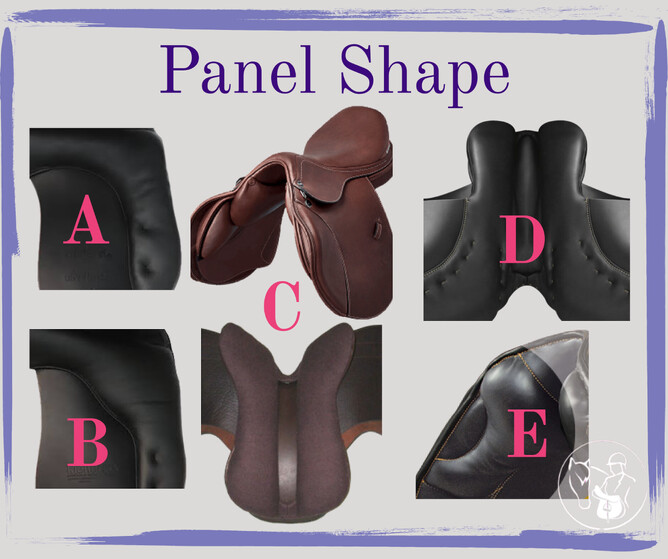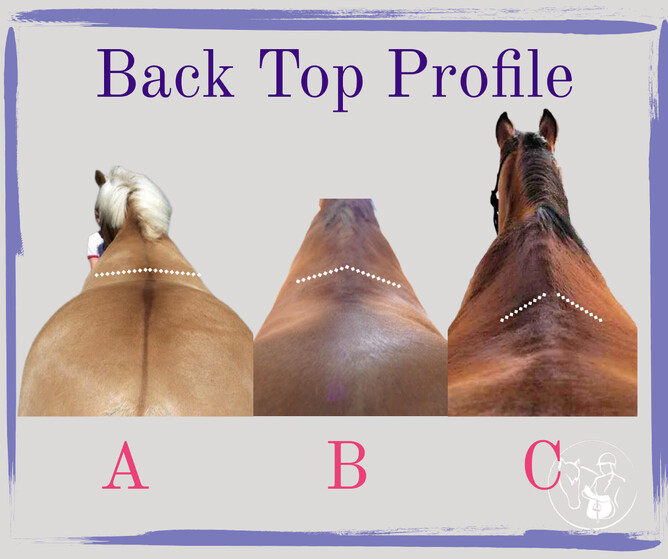Another often confusing concept in the world of saddles, is panel shapes. So why do we have different shaped panels? And why is it so complicated?
Well this area of saddle fit alone has a few sub categories
Panel shapes
Gusset types
Panel fills
Panel materials
The different kinds of panels
Using the KISS concept, let's start with basic panel shapes. The below picture has the typical panel shapes that we see on modern saddles.
STANDARD PANEL (A)
This panel is commonly used for wider horse's back. Typically ponies, cob, draught, and the more modern warmblood shape. These panels are used to have a lower profile to keep the saddle close to the horse's back (less chance of a rolling saddle and the rider feels near the back).
DROP/ MODIFIED/ K PANEL (B)
This panel has an extra width behind the shoulder area and is used to help support lift/ stop the saddle getting sucked down or dropping low over the wither. Commonly used for horses with Thoroughbred heritage, NZ sports horse, downhill conformation or horses with long and/ or high withers.
SHORT PANEL/ SL/ SHOULDER FREE/ PERFORMANCE PANEL (C)
Various companies have a different name for it, but the shape is the same, a shortened panel in the front to allow the panel to sit unhindered behind the scapula area and allow the flap of the saddle to be independent and as such, avoid influence on the shoulder on pushing the saddle back. These panels are dependent on the tree they are on as to what horses they suit. Brands that have long tree points can use these on high-withered horses. Brands with short points recommend using these on the wider, more heavily muscled horses.
QUILTING STITCHED PANEL (D)
This can actually be on any shaped panel but is a way of holding the wool in place to create a close contact feel for the rider. These panels are most commonly used on the wider backed horses as they restrict much rebalancing, and are often found around the front half where the riders leg hangs down to give them a close feel (any stitches that run down the entire length of the panel should be binned). This can also be used to keep wool away from the trapezius for anatomical freedom. The downside is it does prevent much adjustability in the panel.
CUT AWAY PANEL (E)
A few brands offer panels with this feature, although predominantly this is used with a foam panel. The concept is to allow the shoulder to move back and forth without touching the panel, and is more commonly used for wider backed horses, it can also be used on narrower shapes.
So we have panels that are designed to fit different back conformations, and commonly the type of panel we have will also give you a clue to the type of tree shape the saddle may have (this is not a hard and fast rule!). A tree which has medium to good curve will usually have a drop panel as this helps keep the tree stable and in balance on a back that slopes away from the spine. A flatter tree will generally have a standard or short panel as these are designed for close contact and stability on a wider back shape, the kind that is muscled either side of the spine.
Let's take a look at the picture below, back profile shapes from the top. Now there are things that can influence this shape for your horse:
Weight
Age
Fitness
Injury
But this is another topic...
The different kinds of profile
Keeping it simple, If we look at picture two, we can see we have 3 main shapes (and a variety of shapes in between).
FLAT BACKED (A)
A mutton withered body shape, usually with well sprung ribs and has a muscle bound back which if you were to put a cup & saucer on the spine, would sit on the muscle.
AN AVERAGE CURVED BACK (B)
This horse has a little muscle covering either side of the spine, but tends to have average to narrower sprung ribs. If you were to place a cup and saucer on this back shape, the edges of the saucer would have no contact on the edges.
ROOFY / A-FRAMED / CURVED BACK (C)
This horse has the spine as the highest part of the back, and slopes down towards to the ribs which are average to narrow sprung. If we sat a cup and saucer on the back, it would only sit on the spine.
So, now you can see how the shape of your horses back will influence the choice of panel your saddle will ideally have. Hopefully this has given some more insight into the type of knowledge your saddle fitter has, and why some brands or models are recommended and others aren't.
What is a drop or K-panel, and when is it used?
A drop or K-panel features extra width behind the shoulder area to prevent the saddle from sinking over the withers. It’s ideal for horses with high withers or downhill conformation, such as Thoroughbred or NZ Sport Horses.
What type of panel is best for wide-backed horses?
Standard panels or quilting-stitched panels work well for wide-backed horses. These panels offer close contact and stability, fitting snugly on muscled backs without much adjustment needed.
How does my horse’s back shape affect panel choice?
Flat-backed horses benefit from standard or short panels, while curved or roofy backs may require drop panels for better saddle balance. Your horse's age, weight, fitness, and past injuries can also influence back shape and saddle fit.






